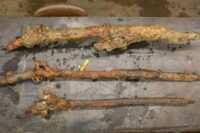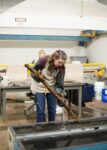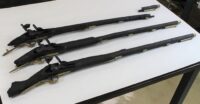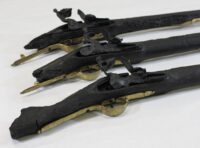 Three muskets recovered from a Revolutionary War-era shipwreck off the coast of St. Augustine, Florida, have been liberated from thick layers of concretion to reveal intact stock, lock, and brass furniture. The hardened outer layer of corrosion, sediment and marine life took years of painstaking conservation to remove.
Three muskets recovered from a Revolutionary War-era shipwreck off the coast of St. Augustine, Florida, have been liberated from thick layers of concretion to reveal intact stock, lock, and brass furniture. The hardened outer layer of corrosion, sediment and marine life took years of painstaking conservation to remove.
The muskets were recovered from a site known as the Storm Wreck which was discovered in 2009 and excavated by marine archaeologists, students and volunteers with the Lighthouse Archaeological Maritime Program between 2009 and 2014. The wreck was one of a fleet of more than 130 British ships, Royal Navy and private, that were enlisted to evacuate Loyalists from Charleston, South Carolina, to the safety of British East Florida in December 1782. They succeeded in fleeing the threat posed by the Continental Army, but for the Storm Ship, the topography of British East Florida itself would be fatally dangerous. The ship ran aground on the treacherous sandbar of St. Augustine on New Year’s Eve, 1782.
 Hundreds of artifacts have been recovered from the site, including two British cannons stamped with the date 1780, buttons from regimental uniforms of the Royal Provincial, the 63rd Regiment of Foot and 71st Regiment of Foot, a gentleman’s pocket pistol and the ship’s bell, which is unfortunately devoid of markings so we still don’t know the name of the ship. There are no Royal Navy motifs, so it may have been privately owned.
Hundreds of artifacts have been recovered from the site, including two British cannons stamped with the date 1780, buttons from regimental uniforms of the Royal Provincial, the 63rd Regiment of Foot and 71st Regiment of Foot, a gentleman’s pocket pistol and the ship’s bell, which is unfortunately devoid of markings so we still don’t know the name of the ship. There are no Royal Navy motifs, so it may have been privately owned.
Many of the recovered objects were obscured inside “rocks” of massed concretions. Conservators took x-rays of the concretions to map out the  artifacts within and develop a plan to remove the layers while replacing the salts that will eat away at the object as soon as it is exposed to air. An x-ray of one of the Brown Besses revealed a lead shot that looked like it was in the barrel but was actually to the right of it embedded in the concretion material.
artifacts within and develop a plan to remove the layers while replacing the salts that will eat away at the object as soon as it is exposed to air. An x-ray of one of the Brown Besses revealed a lead shot that looked like it was in the barrel but was actually to the right of it embedded in the concretion material.
Conservators removed the outer layer of corrosion to reveal the muskets, complete with intact stock, lock, and brass furniture. The stocks were preserved in polyethylene glycol, to bulk and support the waterlogged wood cells as they dried.
The brass furniture included the ramrod pipes, side plate, wrist plate, trigger guard, and trigger plate, all conserved using electrolysis and later affixed to the dried stock. The locks were partially corroded away and partially preserved; leaving an intricate shape that required step-by-step casting and removal of the corrosion. The locks were the last feature added back to the stocks, which completed the treatment and readied the muskets for eventual display at the St. Augustine Lighthouse & Maritime Museum.


The Kalb family in our small Franconian village had one of their sons fighting in the US Revolutionary War, but by August 1780, he was already dead. Before he ended up in what later would become the US, he had taken part in the War of the Austrian Succession in Flanders, and in the Seven Years’ War on behalf of the French. They were all Freemasons.
On recommendation of Étienne François, duc de Choiseul, who acted as Foreign Minister of France, Johann Kalb went to North America in 1767 and 1768 to investigate the mood of the colonial population there toward the British (in 1764, a M. de Fontleroy had been sent). In 1777, shortly after the outbreak, Kalb went back to America with Lafayette.
In December 1779, Washington placed him in command of the Maryland and Delaware divisions to cover Charleston. However, the city had fallen before his arrival on May 12, 1780, so Kalb retreated south and on August 16, under Gates, participated in the Battle of Camden. In this battle Kalb was mortally wounded and died on August 19.
The British held Charlestown for over a year. Alexander Leslie, commanding Charlestown, requested a truce in March 1782 to purchase food for his garrison. Nathanael Greene refused and formed a brigade under Mordecai Gist to counter British forays. Charlestown was finally evacuated by the British in December 1782. Apparently, their guns ended up in Florida.
:hattip:
Friends,
The post doesn’t say if the musket barrels were brass or steel. I’m thinking steel, given that the buttons associated with this find are from British Army infantry regiments.
Special Brown Bess muskets were manufactured with brass barrels, and most other parts also made from brass, for the Royal Navy and the Royal Marines (remember the Red Coats on the ship in MASTER AND COMMANDER?). At sea, brass resists corrosion better than steel resists rust.
Most Royal Navy frigates at that time would have had a detachment of Royal Marines. If other weapons are recovered, brass barrels might be a further clue to whether this was a British Navy ship, a civilian ship under contract, or just a private ship fleeing Charleston.
Obviously there are some brass parts on these guns. Brass was often used for furniture such as butt plates and straps on land infantry weapons. Even an armory-grade musket was often a work of great beauty in those far off times.
Yours Aye,
Lord Mungo Napier, Laird of Mallard Lodge, SCA
(Who is more comfortable with a longbow!)
Lord Napier:
I’m not at all sure of how correct you are about brass barrels on sea service pattern Brown Bess muskets. I doubt that brass would be strong enough to resist bursting at the pressures reached in muskets and all the illustrations I can find of sea service muskets (slightly shorter barrels and weight than the short land service variants) on the internet appear to have steel barrels. Also, and this is a quibble, cannon or pistols with “brass” barrels are made of gun metal, a type of bronze (no zinc in the alloy).
Garwed Cadburiensis, MSCA
George,
I am apparently in error about brass or even bronze barrels on British naval muskets. I had heard of such weapons somewhere, but can find no references to them.
The British Naval Pattern Musket had a steel barrel, but only 37″ long (versus 46, 42 and 39 inches for successive models of the Land Pattern Musket). The barrel was apparently blackened to resist rust at sea, but was steel. This model was in use from 1778 to 1854. Wikipedia says this naval model was used by both marines while at sea, and ship’s crew.
Yours Aye,
Mungo 🦆